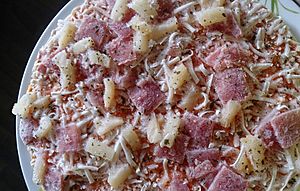Frozen food facts for kids

Frozen food is food that has been frozen to keep it fresh for a long time. Freezing food is a great way to stop it from spoiling quickly. This means that frozen foods often don't need extra chemicals called preservatives to stay good. You'll usually find frozen foods packaged in bags or boxes.
Many different kinds of food are frozen, like vegetables, pizzas, and chicken.
Contents
Why We Freeze Food
Freezing is one of the oldest and simplest ways to keep food safe and tasty. When food is frozen, the very cold temperature stops tiny living things, like bacteria and molds, from growing. These tiny organisms are what make food go bad. Freezing also slows down chemical changes that can spoil food's taste or texture.
This method helps us enjoy foods that might only be available at certain times of the year, like fresh berries, all year round. It also helps reduce food waste because food lasts much longer.
How Freezing Works
When food freezes, the water inside it turns into ice crystals. These ice crystals make it hard for bacteria to grow because they lock up the water. For food to stay good, it needs to be frozen quickly and kept at a very cold temperature, usually 0°F (or -18°C) or colder.
When you want to eat frozen food, you simply thaw it out. This means letting it warm up until the ice turns back into water. Then, you can cook it just like fresh food.
Types of Frozen Foods
You can find almost any type of food in the freezer aisle of a supermarket.
- Fruits and Vegetables: Many fruits like berries, corn, peas, and broccoli are frozen soon after they are picked. This helps them keep their vitamins and nutrients.
- Meats and Seafood: Chicken, beef, fish, and shrimp are often frozen. This helps them stay fresh during transport and storage.
- Prepared Meals: There are many frozen meals that are ready to cook, like pizzas, lasagna, and even full dinners. These are super convenient when you need a quick meal.
- Baked Goods: You can also find frozen breads, pastries, and desserts.
Benefits of Frozen Food
Frozen foods offer many advantages for families and individuals.
- Convenience: They are easy to store and quick to prepare, which is great for busy schedules.
- Nutrition: Often, fruits and vegetables are frozen at their peak ripeness. This means they can keep more vitamins and minerals than fresh produce that has traveled a long way.
- Cost-Effective: Buying frozen can sometimes be cheaper than buying fresh, especially for out-of-season items.
- Less Waste: Since frozen food lasts longer, you are less likely to throw it away before you can eat it.
History of Frozen Food
People have used cold to preserve food for thousands of years, using ice and snow. But modern frozen food, as we know it today, really started in the early 20th century.
A man named Clarence Birdseye is often called the "father of frozen food." In the 1920s, he saw how people in Labrador, Canada, froze fish almost instantly in the extreme cold. He realized that freezing food very quickly made it taste much better when thawed. This is because quick freezing creates smaller ice crystals, which do less damage to the food's cells. Birdseye developed special freezers and packaging, and by the 1930s, his frozen foods were sold in stores. This changed how people bought and ate food forever!
Images for kids
-
A frozen processed foods aisle at a supermarket in Canada
-
Cutting frozen tuna using a bandsaw in the Tsukiji fish market in Tokyo, Japan (2002)
-
A frozen food warehouse at McMurdo Station, Antarctica
See also
 In Spanish: Congelación de alimentos para niños
In Spanish: Congelación de alimentos para niños





